-
Posts
1,262 -
Joined
-
Last visited
Content Type
Profiles
Forums
Events
Store
Posts posted by Andrej Stancak
-
-
Sandy:
I found a better version of Figure RIT 4.1 in the HSCA report, page 182. It shows that the bottom two squares did really stand out from the brick wall and therefore, cannot be used for any pincushion analysis. Naturally, a small pincushion effect is present also in the picture below, however, it is not that strong as indicated with your blue lines which wrongly copy the bottom rectangles. In contrast to the bottom squares, which appear to be framed, the top square is mounted flat and fixated in the corners with pieces of tape. This square reveals an optical problem of this particular camera which appears to have been overlooked for so many years. As I am constructing the 3D model of the doorway, I can now trust rather my model in terms of the vertical lines than the pictures from this camera - the program does not know about any imperfections of this particular Imperial camera.
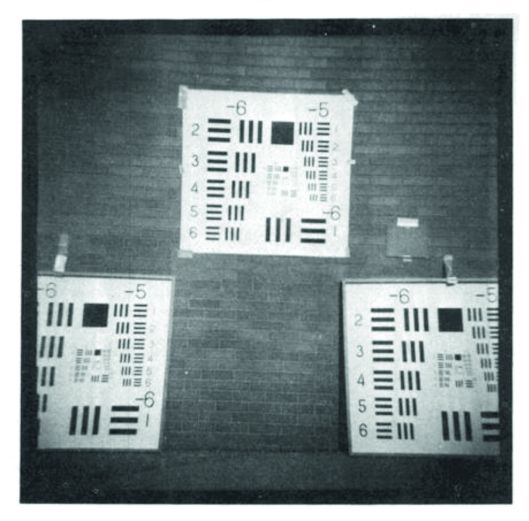
This picture is very useful. It shows that the vertical lines in the bottom part, especially in the centre of the picture, were straight. The problem is the right upper quadrant, especially the part which is occupied by the right top part of the square. It causes the vertical line to fall rightwards, and maybe the horizontal lines downwards.
To convince you that Oswald's camera distorted the pictures especially in the upper right quadrant, I am posting a family picture made by Lee Oswald. There are no guiding lines here, however, I hope you can extend the edges of the top square into the family picture (I have aligned the left edge of the top square with the brick column in the upper picture). The brick column is straight, however, the windows grills further to the right and the right wall fall towards the right. Please, note the leftward orientation of the window in the left part of the family picture, exactly as in CE133A.
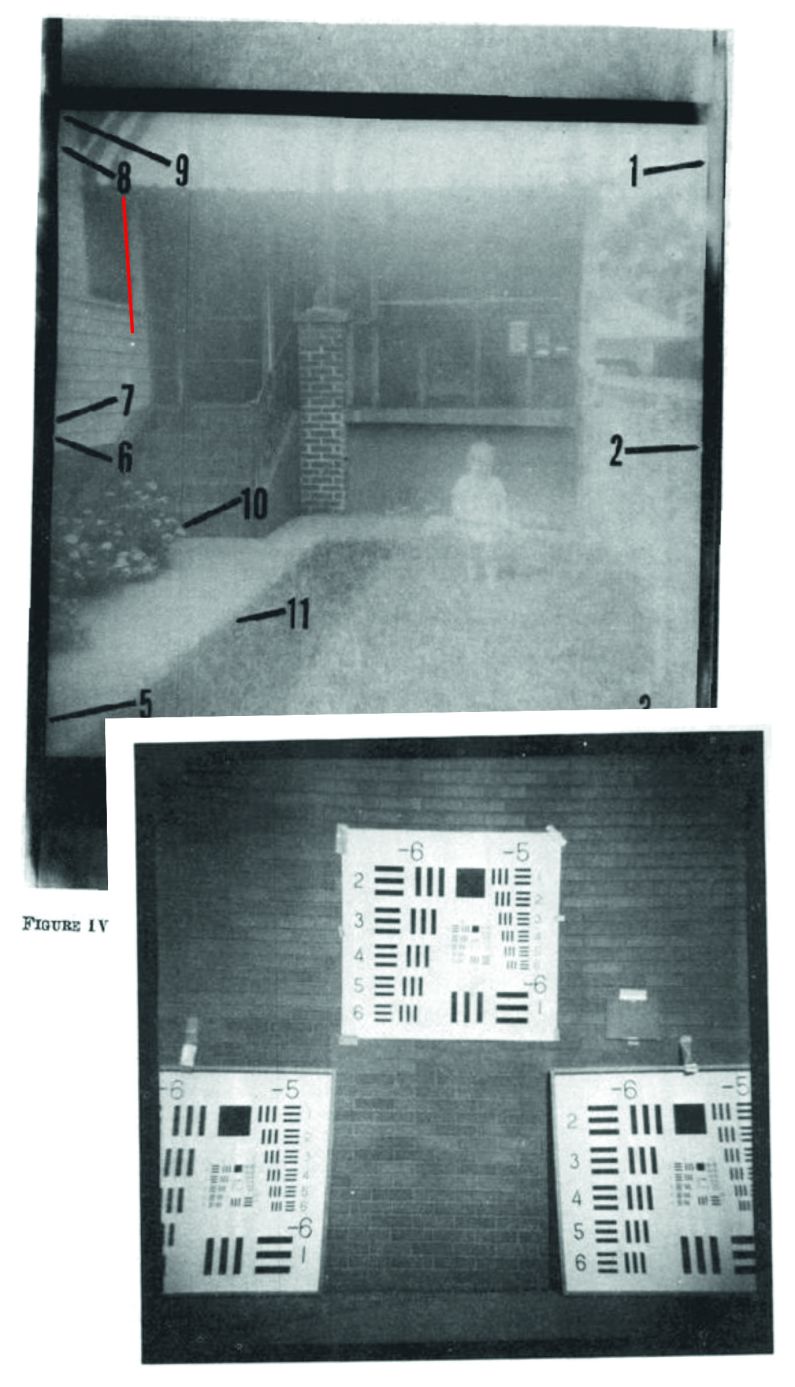
I hope I have answered your queries. I am posting below the updated alignements of RIT 4.1. and the three backyard pictures.
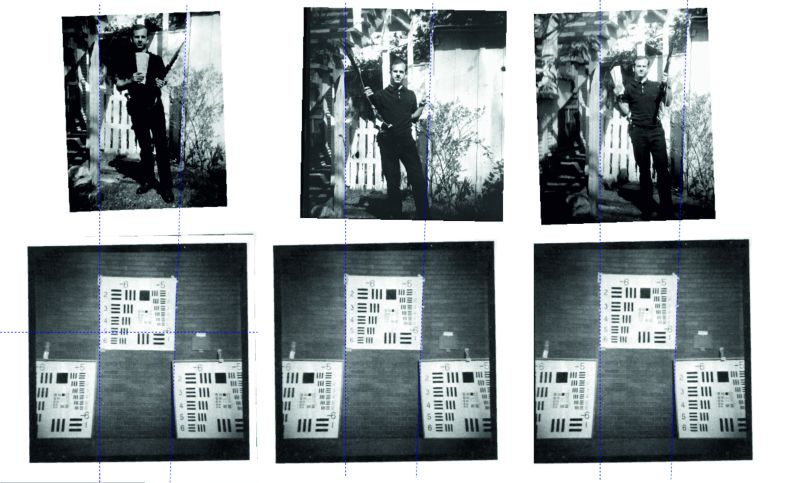
-
Please find here a comparison of the backyard picture with my simulation of Oswald's pose. The purpose of this small experiment was to show the maximum leaning angle provided that: 1) the front part of the left foot touches the ground, 2) all weight rests on the right foot, 3) the trunk and the head align with the vertical plane perpendicular to the ground. The arms simulate Oswald's pose only approximately, however, it was not the purpose of this experiment to reproduce all aspects of Oswald's pose. Also, the right foot is rotated slightly more compared to Oswald's stance...
The angle of leaning in the right picture appears even larger than in the original backyard picture. This is highlighted in the picture below. The yellow line in Oswald's figure connects the tip of the left foot with the nose, and crosses the left knee. In the right hand side figure, the same line was copied to cross the tip of the left foot. However, the yellow line misses the nose by a large margin. Thus, Oswald's pose looks strange on the first sight, however, it can be reproduced. Holding a rifle weighing 3.4 kg would make the pose even more stable. I have tested this condition by reproducing the pose whilst holding a stone weighing about 3 kg in my left hand (not shown).
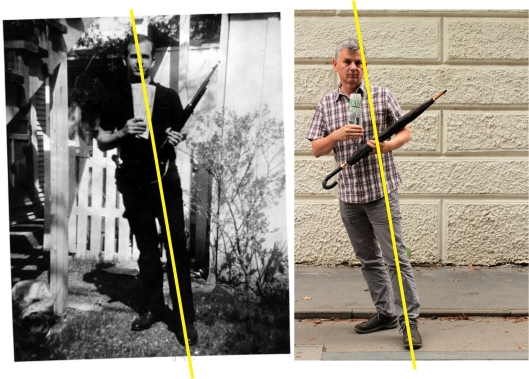
The new pictures were taken by my daughter. Interestingly, I had to ask her to make sure in the next round of shooting that the vertical lines are really vertical and the horizontal lines are horizontal. The reason was that my daughter rotated the pictures towards the right in maybe a subconscious effort to correct the strong leaning as if trying to avoid my falling down. Could this be the reason for seeing this particular backyard picture rotated towards the right?
Andrej, surely you see that the yellow line drawn passes directly through LHO's head, but only grazes your left ear.
The center of gravity is not the same. That's beside the fact that your right toes are keeping your balance -- unlike LHO's.
Regards,
--Paul Trejo
Paul:
The purpose of this small experiment was to show that extreme leaning is possible without falling down. Here I showed a pose which inclined even more than Oswald's pose. I had no intention to reproduce the exact Oswald's pose in CE133A - this would require a thorough preparation, shooting pictures by triggering the camera from the laptop, inspect the result by comparing each new picture with the backyard picture, and shooting again. It should also involve preparation of an object of similar shape and weight as the rifle held in man's left hand.
The center of mass analysis has some limitations. The rifle held by the left hand was an essential component in keeping this posture stable. Further, the man's body is not a sack of potatoes which would fall or not depending on the location of centre of mass. Human's foot muscles (actually the tibial muscles) can exert force which counteracts the gravitation force, hence it is not just a calculation of centre of mass as in the paper from Dartmouth university.
-
And here we go with CE 133B and RIT 4.1. - the same angle. The backyard picture was rotated to have the staircase post vertical.
This is impressive, Andrej, but here is the further challenge. We have not one, but four different BYP poses.
To add confirmation to your demonstration, you must show that this angle applies to ALL FOUR of the BYP poses. Can you?
Regards,
--Paul Trejo
Paul:
I am not sure I am familiar with the fourth backyard picture. Please post it or a link if possible. Thank you.
OK, this is getting more interesting, Andrej. Here's my understanding of it.
You have shown three poses -- and yet there were four BYP's. Yet, there were really only three poses of Roscoe White (in my theory) and the fourth pose was LHO himself.
And, we don't have the original pose by LHO (in my theory).
However, for 133-A, we have TWO DIFFERENT VERSIONS, and this is what I was thinking of, when I said four BYP's.
The two different versions are the 1st one found allegedly in Ruth Paine's garage (CE-133A) and the 3rd one found by Jeanne and George DeMohrenschildt in 1967, (CE-133A-deM) around the time of the Jim Garrison scandal.
This is the same pose -- BUT A WIDER BACKGROUND than the Ruth Paine model. Perhaps you have seen the difference. Here is a link:
http://www.jfklancer.com/Rifle.html
Now -- it you have proven that Jack White was mistaken about his "Keystone" theory -- then I'm duly impressed. I always thought that Jack White was decades ahead of everybody else in this regard. You might have surpassed him, and that's spectacular, if you have. One more photo should do it, IMHO.
Now, having said that, it does not change the question of pasting LHO's head onto Roscoe White's body. The Imperial Reflex camera was the same -- according to your findings -- but the body-double question remains open, in my reading.
I personally see a lump in the right wrist of the BYP -- and LHO didn't have such a lump -- but Roscoe White did. I wonder if you are working with the most original copies.
I have asked NARA for exact replicas back in 2013, but they denied my request.
Regards,
--Paul Trejo
Paul:
You raised many interesting question, and I hope that this thread will answer many if not all of them. Too bad that NARA did not volunteer to give you copies of backyard pictures.
I have the highest appreciation for Mr. Jack White's work. He was limited in his research by the technical possibilities of that time. I am sure he would be delighted to see that researchers continue to search for the truth about the backyard photographs. And if some of components of his research would now be updated, so be it - this does not detract from his work at all. However, it would be a mistake not to check Mr. White's findings and conclusions.
-
I have flipped a different version of CE133A, the one showing more of the background, and it does not look to me any more suspicious than the unflipped version. We come to the pose itself soon.

-
And here we go with CE 133B and RIT 4.1. - the same angle. The backyard picture was rotated to have the staircase post vertical.
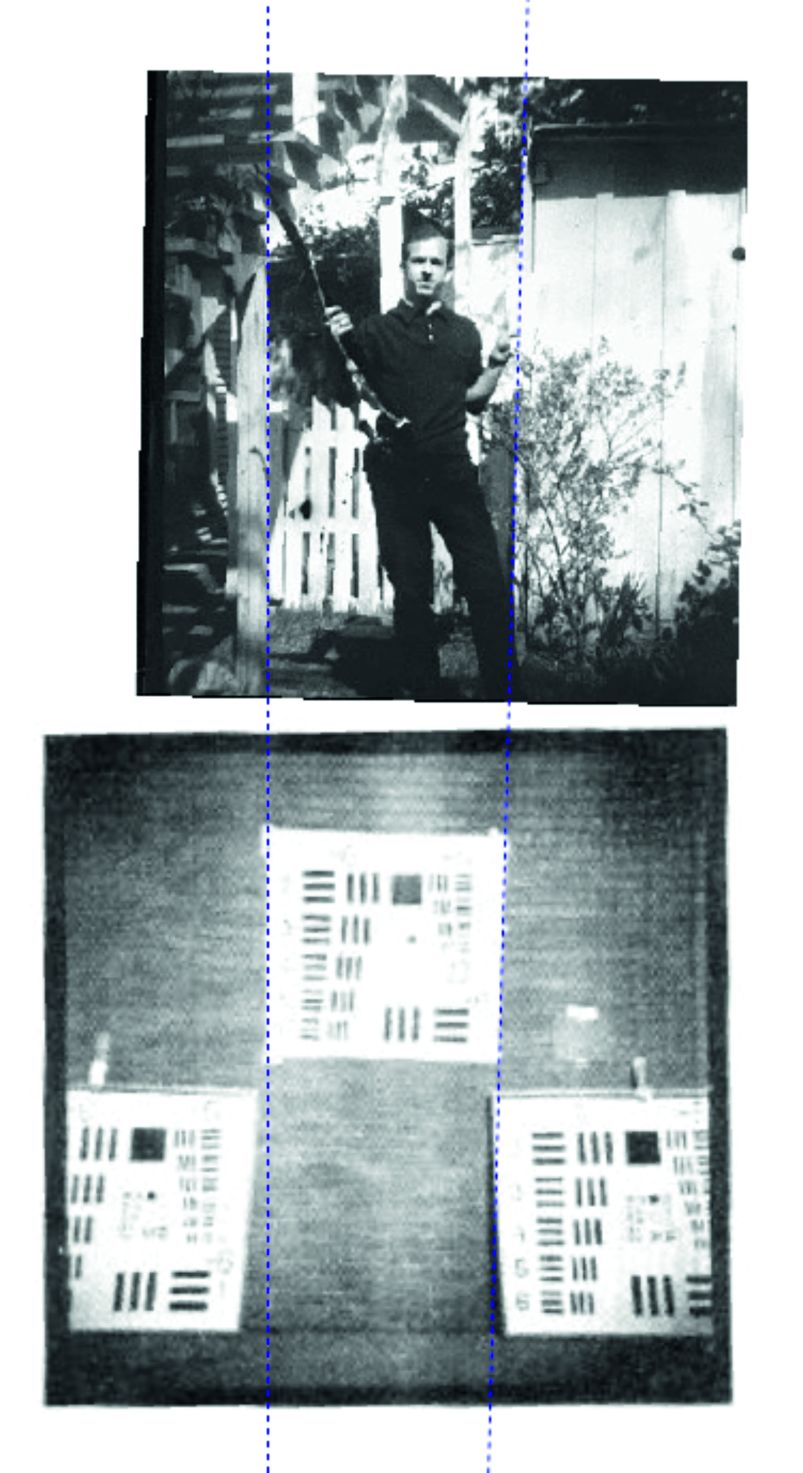
This is impressive, Andrej, but here is the further challenge. We have not one, but four different BYP poses.
To add confirmation to your demonstration, you must show that this angle applies to ALL FOUR of the BYP poses. Can you?
Regards,
--Paul Trejo
Paul:
I am not sure I am familiar with the fourth backyard picture. Please post it or a link if possible. Thank you.
-
Tom:
Your new ICOs are brilliant as always. I would wait with the angle of Oswald's body inclination because I would not be able to say responsibly at this moment. The 3D reconstruction of his stance is more or less finished, however, I see still some minor problems with the arms. We come back to it then if you would agree.
-
Finally, please see the alignment of RIT 4.1. and the CE-133c. Again, a very good match. Thus, my answer to the question I asked in post No. 239 would be that the Imperial camera had an optical problem causing the vertical lines in the right part of the picture to be displaced towards the right. Thus, keystoning was in place, however, it was a natural phenomenon which related to a certain malfunction of this particular camera. Further, it is almost excluded, in my opinion, that this defect was present in every Imperial camera. Therefore, the divergence of the vertical lines actually cements this particular camera as the one used to take all three backyard pictures.

-
And here we go with CE 133B and RIT 4.1. - the same angle. The backyard picture was rotated to have the staircase post vertical.

-
The problem of Figure RIT 4.1., exhibits of the HSCA, can be understood from the picture below. It shows the lines extending the left and right edges of the top square. These lines create an angle opening upwards. And surprise, surprise: the same angle applies to the angle created by the rightwards falling vertical edge of the fence and the staircase vertical post next to Mr. Oswald.
Well, this match cannot be a coincidence. There are only two explanations for having these angles in a perfect match: 1) The Imperial camera had an optical problem, such as e.g., the mirror in the camera slightly misplaced relative to the axis of the lens (tilted) creating "keystoning" on every snap; therefore, RIT 4.1. and the backyard picture had to show identical anomaly, and actually this anomaly strengthens the authenticity of the backyard picture. 2) The RIT 4.1. was rigged to show an anomaly which exactly matched the alteration made in the backyard picture. Any preference?
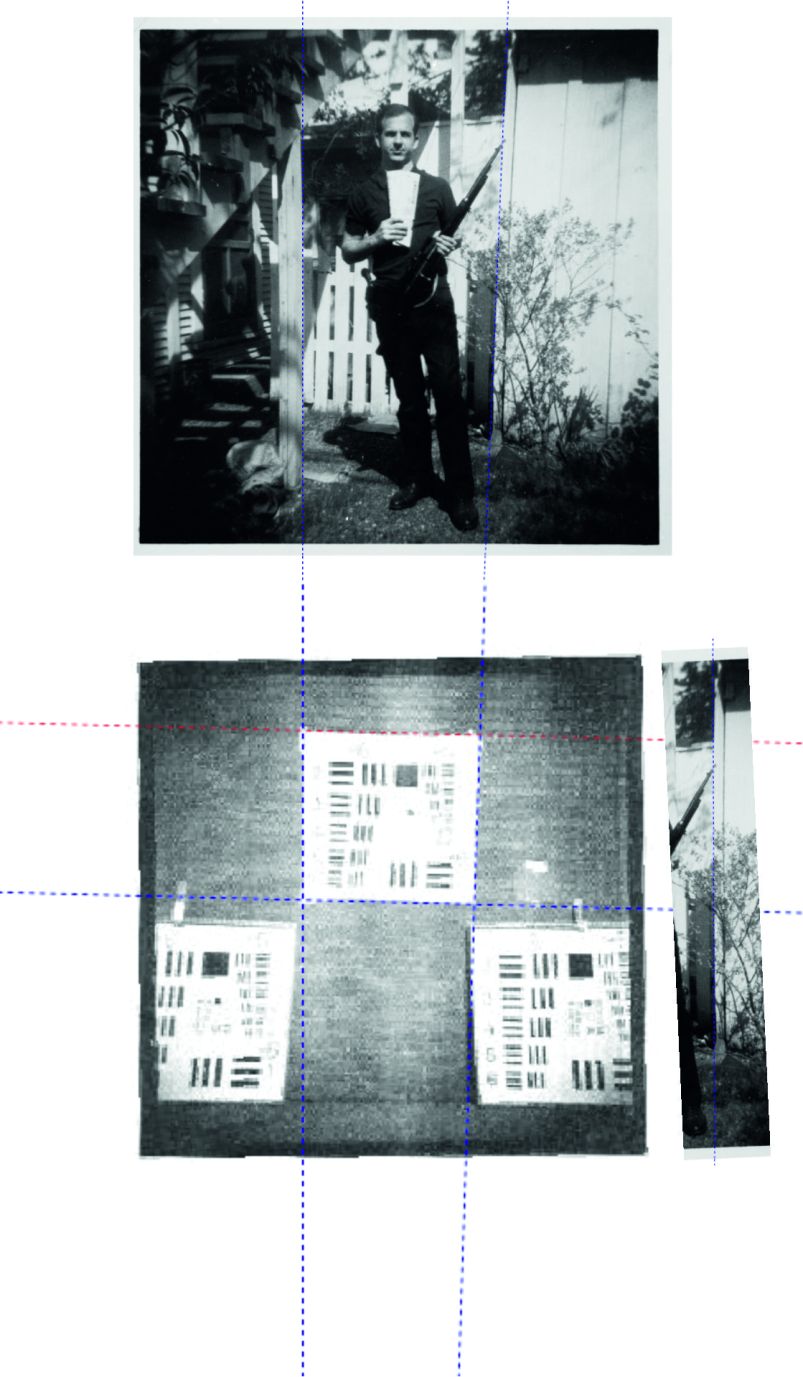
-
The House Select Commitee experts tested the Imperial camera allegedly used to shoot the backyard photographs. One of the tests carried out at RIT was the analysis of curvatures produced by the lens. The left panel is the HSCA exhibit FIGURE RIT 4.1 which can be downloaded as http://jfkassassination.net/russ/infojfk/jfk6/6figrit4ap188.jpg .
I have rectified the left vertical edge of the middle square which appears to be well mounted. This is illustrated in the right panel. Interestingly, the right vertical edge line is not parallel to the left one, instead it diverged rightwards creating an open angle towards the top of the picture. The horizontal lines were supposed to be orientated perpendicular to the left vertical edge, however, they rather show a decline towards the right of the image.
Could the optical features of the lens be the cause or at least a contributing factor in the divergence of the vertical lines (fence) in the right part od the backyard picture?
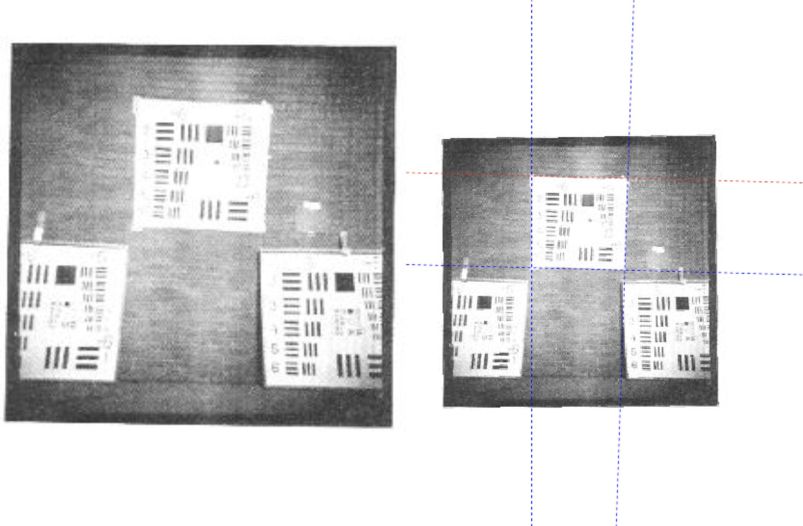
Andrej,
The camera is exhibiting pincushion distortion, which is an inherent feature (i.e. not caused by a flaw) of all lens elements. (Though the distortion can be, and is, compensated for and minimized in most camera lenses.)
 oswald_camera_pincushion_distortion.jpg
oswald_camera_pincushion_distortion.jpg
Pincushion/barrel distortion always results in curved lines. Since the BYP lines are not curved (they are only slanted), we know that their angles must be the result of either perspective or keystoning, NOT pincushion. And since the vertical lines in the BYP diverges at the top but not at the bottom, then we know that perspective isn't at play. (Because perspective distortion is always symmetrical about the lens's axis.) That leaves only keystoning as the cause of the angled lines.
Sandy:
the backyard picture shows a pincushion effect as it should, however, this is a very minor change to the course of the vertical lines compared to the displacements we see in Figure RIT 4.1 of the HSCA. The picture below takes the vertical edge line of the fence in the right part of the backyard picture. I drew a blue dot line which runs in parallel with this edge line and touches it in the middle (left panel). The middle and the right panel show magnified views of the top and bottom part of the vertical fence line. The edge line deviates from the straight blue line as expected if pincushion is present: in both the top and bottom parts the edge line bends to run towards the right hand side. The size of pincushion is very small, and this was the reason that for practical purposes we have treated the vertical lines in the backyard picture as perfectly straight in previous posts. They are not straight though - a small pincushion effect is present. The small size of pincushion is logical because the lens used was a 35 mm one and the film frame was a square of 6x6 cm - this is a pretty wide-angle setup. Pincushion is usually seen in a telephoto type of lenses.
I would not agree with your pincushion drawing in the RIT 4.1 picture. The displacement seen in RIT 4.1 is dramatic and exceeds by a large margin the pincushion effect I show in the picture below. Please note how poorly is the bottom right square in RIT 4.1. mounted on the wall - it flips away from the wall and creates a curvature which you assimilated into your blue pincushion line. One can see even a shadow cast by the left edge of the square. So, there must be a different explanation for the rightwards running top square in RIT 4.1.
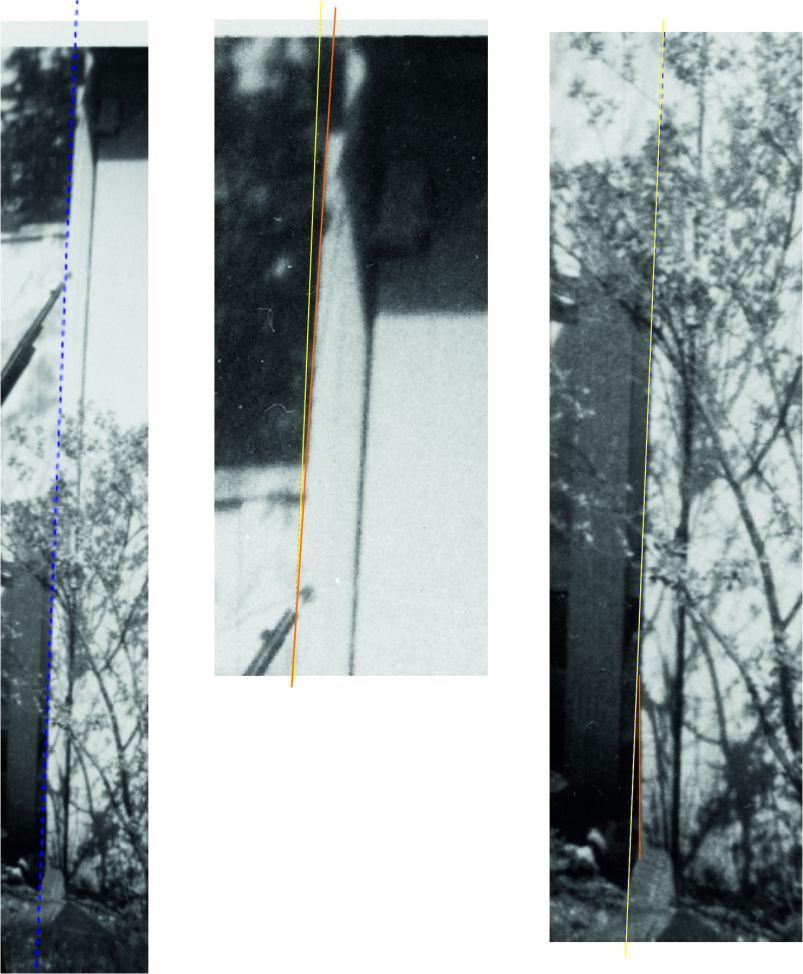
-
Rob:
Marina’s testimony raises serious doubts because of the points you mentioned. It will be difficult to find out the full truth about these pictures which had damned Oswald, but also Marina, so much. Mrs. Marina Porter is alive and there is still a small chance to learn more details about these pictures from her. Actually, Marina has admitted taking the pictures because Lee asked her to do so:
https://www.youtube.com/watch?v=5IJCCBZxpCY
There is a woman’s handwritten note in perfect Russian “Ochotnik za faschistam, hoi-ha-ha!” on the back of one of the backyard pictures. It is very likely that it was actually her note. If so, that would indicate her good knowledge of the pictures. If it is true that she has destroyed one of the pictures right on the 23rd or 24th of November, then she understood very well how damaging these pictures were both for Lee and herself as the one who potentially assisted the President’s assassin. The pictures not only show Mr. Oswald as a potential political aggressor, they also pointed to his association with the infamous rifle. Marina was in a difficult position and had tried to tune down her role in taking the pictures by only reluctantly admitting taking one, then two pictures after being shown the other picture. She might have admitted taking more pictures during her WC testimonies if additional pictures would be submitted to her. Thus, she clearly revealed as little as possible about the backyard pictures. It is true that she did not present herself as a very trustworthy witness, however, her situation was such that this little what is in her testimonies may still be the minimum truth she was willing to concede. Her interviews (links above) suggest she indeed took the pictures, and maybe more than two.
I have tried to check the likelihood of the pictures being taken on March 31. The shadows cast by the man’s figure in CE133A would match Sunday, March 31, for the period between 11.30 and 12.00, very likely 11.37. It is a very indirect yet at least some empirical support for the possibility that the pictures were taken by Marina on Sunday morning when Lee was at home and not at work.
Lee’s denial of the pictures may have had also the purpose to protect Marina as the pictures made her a potential accessory to the fact. His denial and his accusation of DPD involvement in these pictures were maybe also his big mistakes comparable to exclaiming he was a patsy or trying to call his cut out in North Carolina. The right people had realised he would not take the blame and that he knew about them.
-
The House Select Commitee experts tested the Imperial camera allegedly used to shoot the backyard photographs. One of the tests carried out at RIT was the analysis of curvatures produced by the lens. The left panel is the HSCA exhibit FIGURE RIT 4.1 which can be downloaded as http://jfkassassination.net/russ/infojfk/jfk6/6figrit4ap188.jpg .
I have rectified the left vertical edge of the middle square which appears to be well mounted. This is illustrated in the right panel. Interestingly, the right vertical edge line is not parallel to the left one, instead it diverged rightwards creating an open angle towards the top of the picture. The horizontal lines were supposed to be orientated perpendicular to the left vertical edge, however, they rather show a decline towards the right of the image.
Could the optical features of the lens be the cause or at least a contributing factor in the divergence of the vertical lines (fence) in the right part od the backyard picture?

-
Paul:
you see in my post 40 that the rightward inclination of the fence in the right part image was also seen in one modern picture which shows the backyard seen from a very similar view angle.
Some of the posts supporting the platform/stairs appear like that they never were perfectly straight and perpendicular to the ground. This may also relate to the downward inclination of the picket which can be seen in almost all pictures of this backyard. If someone would lift the right side of the photographic plate during repeated shooting of the picture, the gate would point upwards, not downwards, and the heights of individual posts would be increasing towards the right. If the left side of the plate would be lifted, we would see anomalies predominantly in the left part of the picture. It would be necessary to see the result of Mr. White's experiment (keystoning) to confirm that this manipulation has occurred.
While I also believe that especially CE133B and C were manipulated, I think that CE133A was actually the picture shot by Marina. It is likely that the CE133A was manipulated in the head/face region which would be what Mr. Oswald indicated during his interrogation.
Andrej,
No, CE 133-A is also manipulated. The square chin is the first clue. Also, the thick neck, the broad shoulders and the lumpy right wrist. All these belong to Roscoe White.
Further, look at the right knee on CE 133-A. Now look at your right-knee in the photo you shared. Your leg is STRAIGHT. Now look at LHO's knee -- it is bent backward.
Actually, look at the line of the horizontal fence-post that intersects the vertical knee point. There is re-touching there.
No, CE-133A is also manipulated. We no longer have the single photo that Marina took. But even Marina herself was fooled -- as LHO was a superb deceiver. He reveled in it.
Regards,
--Paul Trejo
Paul:
you may have not read my comment properly - I admit that manipulations in the head/face area occurred in CE133A, while you try to make an impression that I deny any manipulations in CE133A. The rest of your examples of manipulations are illusory. The right leg is stretched and as the shin is in a slightly unnatural angle, latched into the knee, however, the leg is not bend backwards. The trouser around the knee makes a fold which creates a bil of illusion that the leg is bend in opposite direction. The right wrist in CE133A appears normal to me. The shoulders are not particularly broad - I was modelling this figure in Poser and had to reduce the standard size of the shoulders to match the picture.
Now, what would be the reason for Marina taking pictures of Roscoe White? Or did she photograph Lee, and then Lee's figure was replaced with Roscoe's figure, and then Roscoe White's head again by Lee's head. Naturally, tilting of the right (or left?) side of the picture would be a good ingredient to this mess. And if Roscoe was photographed - how did he achieve this specific pose if the pose would be impossible?
-
Know why the perspective is all wrong in the BYP?
Sandy pointed out that the posts on the right lean right, the window on the left leans left, and the support post for the stairs is close to being plumb.
What about the gate itself? The whole thing leans to the right; a match for the 2nd post from the right. It breaks all of the rules.
I agree entirely, Robert. I also think the best explanation for this was given by both Sandy Larsen and Jack White.
The BYP is a photograph of a photograph. Sandy explained that well.
Then, the end result which defies gravity is made by lifting one end of the photograph before the final snapshot, as Jack White explained.
This was obviously done DELIBERATELY, for PLAUSIBLE DENIABILITY, almost certainly by LHO himself at JCS during the same period in which LHO created his fake Alek J. Hidell identification cards.
Regards,
--Paul Trejo
Paul:
you see in my post 40 that the rightward inclination of the fence in the right part image was also seen in one modern picture which shows the backyard seen from a very similar view angle.
Some of the posts supporting the platform/stairs appear like that they never were perfectly straight and perpendicular to the ground. This may also relate to the downward inclination of the picket which can be seen in almost all pictures of this backyard. If someone would lift the right side of the photographic plate during repeated shooting of the picture, the gate would point upwards, not downwards, and the heights of individual posts would be increasing towards the right. If the left side of the plate would be lifted, we would see anomalies predominantly in the left part of the picture. It would be necessary to see the result of Mr. White's experiment (keystoning) to confirm that this manipulation has occurred.
While I also believe that especially CE133B and C were manipulated, I think that CE133A was actually the picture shot by Marina. It is likely that the CE133A was manipulated in the head/face region which would be what Mr. Oswald indicated during his interrogation.
-
The primary reason Andrej doesn't fall over is because of the way he has his right foot turned.
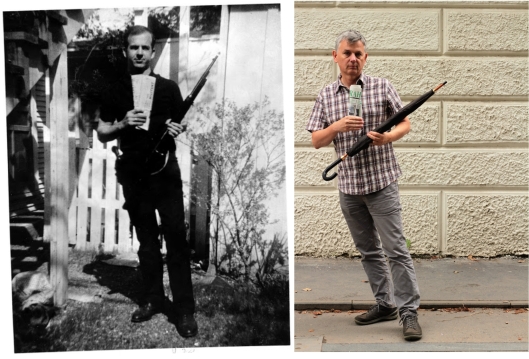
The horizontal lines in the stonework are perpendicular to the force of gravity, unlike the horizontal structures in the BYP.
Robert:
actually, there is still about 1 degree rightwards displacement of the main vertical axis in my picture. in spite of my daughter trying to keep the vertical lines straight. So, my leaning is even more extreme than shown here. As far as inclinations of the vertical lines in the backyard picture, I will come back to it when my model is complete.
-
Gentlemen:
I agree that the orientation of the right foot in my new picture was not identical to the one in the backyard picture. It is more difficult to lean with a smaller angle of the right foot than I have assumed. However, the purpose was to show that a perceptually improbable leaning is possible without invoking the necessity of an alterations to the picture. To show extreme leaning in Oswald's pose with the right foot showing less open angle than I took, one needs to have an (elongated) object weighing 3.4 kg in the left hand. The weigh in the left hand pulls the body towards the left and front. I will produce more pictures in various conditions.
I wondered why would Oswald (or his imposter?) lean like this, The reason may have been the rifle - his intention to have the rifle diagonal to his body. If he would not be leaning, the rifle would have to be held in the diagonal axis as seen in the backyard picture only with man's left wrist else it would hang vertically in parallel with the body. In this particular backyard picture, the weight of the rifle presses against the left forearm, and the left forearm was the body part to keep firm and steady. The leaning in opposite direction has stabilised the left forearm, and the left forearm and the rifle helped to balance the stance.
One can get the feel for this posture by first holding in the left hand an object weighing about 3 kg and then starting to lean to the right and back.
-
Please find here a comparison of the backyard picture with my simulation of Oswald's pose. The purpose of this small experiment was to show the maximum leaning angle provided that: 1) the front part of the left foot touches the ground, 2) all weight rests on the right foot, 3) the trunk and the head align with the vertical plane perpendicular to the ground. The arms simulate Oswald's pose only approximately, however, it was not the purpose of this experiment to reproduce all aspects of Oswald's pose. Also, the right foot is rotated slightly more compared to Oswald's stance.

The angle of leaning in the right picture appears even larger than in the original backyard picture. This is highlighted in the picture below. The yellow line in Oswald's figure connects the tip of the left foot with the nose, and crosses the left knee. In the right hand side figure, the same line was copied to cross the tip of the left foot. However, the yellow line misses the nose by a large margin. Thus, Oswald's pose looks strange on the first sight, however, it can be reproduced. Holding a rifle weighing 3.4 kg would make the pose even more stable. I have tested this condition by reproducing the pose whilst holding a stone weighing about 3 kg in my left hand (not shown).

The new pictures were taken by my daughter. Interestingly, I had to ask her to make sure in the next round of shooting that the vertical lines are really vertical and the horizontal lines are horizontal. The reason was that my daughter rotated the pictures towards the right in maybe a subconscious effort to correct the strong leaning as if trying to avoid my falling down. Could this be the reason for seeing this particular backyard picture rotated towards the right?
-
Sandy:
I agree that the story becomes rather messy, and it seems I have contributed to the misunderstanding. My view is that this particular backyard picture was rotated by about 1.9-2 degrees which causes falling of vertical lines and the small picket fence towards the right. I see no other geometric problem with this picture. The modern picture shown in post 40 attempted to recreate the view of this backyard picture, and included even the rotation applied to the backyard picture. The two yellow lines drawn by myself have very much the same angles as the corresponding lines in the backyard picture. Thus, I say that the divergence of the vertical line was a normal phenomenon as otherwise the modern photo could not reproduce the very similar angle (highlighted with yellow lines). I avoided any comparisons with the post next to the right of Oswald because that one is obviously rotten in the modern picture.
The effect of perspective is a tricky one and depends on the view angle, lens, and the relative distances of objects. Therefore, if this backyard picture is compared to any tourist picture or even other backyard picture, we may not see in those pictures the divergence of the lines seen in this backyard picture, and the fact that actually only this backyard picture shows the divergence of vertical lines does not need to be explained by a manipulation.such as keystoning. I would imply alteration of image only after all possibilities to explain a feature of a picture have failed. I hope that my 3D model will shed some light on this issue as I see no other chance to test further the integrity of the geometric lines in this particular backyard picture.
-
thanks for posting this clip, It shows for the first time the yard from a perspective that is missing in available pictures
my pleasure Andrej.
I'm actually very curious about the height of the stairs and it's support post that is next to Ozzies leg. Unless the ground height has risen considerably in the last 50 years, Oswald would appear to be really small.
Chris:
I hope to post my model of backyard soon, and also hope you would critically check it. If the model would be faithful, it would be possible to measure using the model the height of the backyard man, check the effects of perspective, evaluate shadows, and overlay the 3D model of the man onto the picture, and more. At this moment, I work with the height of the stairs (the level of the top step, not of the small platform about one step above the top step) to be 2.98 m. This height is, naturally, only an estimate. Unless someone goes and measures the dimensions of the house including the height of the platform, there is still some uncertainty about this height estimate. I arrived at it by measuring the planar dimensions of the house (as they project on the ground) using ruler tool in Google Earth. I measured it repeatedly (5x) and calculated the average values. The dimensions I got were 8.80 x 8.08 m. I constructed a house using these dimensions and adjusted the height to match various pictures of the house.This method yielded the height of the house including the height of the first floor level.
Here is one of the working versions of the West Neeley house model.

-
To learn the truth about this picture after 53 years, if it is possible at all. I am relatively new to the JFK assassination research and take nothing for granted. If I am wrong and this picture was geometrically impossible, I will let people know. I have almost no doubts that the heads in other two backyard pictures were altered, and maybe even the chin in this picture. However, the pose appears to me realistic. "Appears" is, however, not good enough.
Well, Andrej, do have photographic equipment that lets you reverse images? Can you take this BYP, and then reverse the image left-to-right? (I don't have such an app.)
If you do, would you show us all? In a normal scenario, reversing the photo never loses the center of gravity -- but in a doubtful case like this BYP, I would expect to see a massive break in gravity. It would be great to see it, to prove it, and to show it to everybody.. Am I wrong? It's easy to test.
Regards,
--Paul Trejo
Paul:
I have no photographic equipment allowing to flip a printed picture. You can surely flip using a digital image using "Flip horizontal" tool which is available even in the most basic photographic programs.
If you are interested in balance analysis, you may wish to read the following:
http://commons.erau.edu/cgi/viewcontent.cgi?article=1206&context=jdfsl
-
Chris:
thanks for posting this clip, It shows for the first time the yard from a perspective that is missing in available pictures
-
Robert:
Hi Chris

Oswald isn't leaning anymore!
(they had to cut most of his left foot off to accomplish this, though)
Robert,
Things are more complicated than they seem. The new tourist picture you show presents a very different field of view compared to the original backyard picture. The focal lengths of the camera used in the new picture differed from that in the backyard picture. Therefore, the divergence of vertical lines will appear different in these two pictures. My post 40 shows another modern picture with a very similar field of view seen in the backyard picture - you can see the divergence of vertical lines very much alike in the backyard picture.
Sorry Andrej, but what you say isn't true. I've been collecting backyard photos and the only one I've found that shows phony perspective is a pro-WC reconstruction dated March 30, 1967. All the others including the modern one in your Post 40 has correct perspective. The one in your Post 40 has simply been rotated.
Here it is with corrected rotation:
Note that the privacy fence on the right is straight and the window pane on the left is straight. These are both pretty plum. The stairway has been rebuilt and its posts are not plum, the nearest one being far from plum. (Compare this post with the same one in Robert's photo... they are both very crooked)
(Note that there is a little bit of pincushion in this photo.)
Don't feel bad... I was fooled at first too.
To repeat... the only photos with the incorrect perspective angles are 1) the one with Oswald, and 2) a WC-friendly recreation from 1967.
Sandy:
rotation of a picture is not a manipulation. I did many photographs using a wet process in my younger years. If the photographer feels the picture needs re-orienting by a few degrees, the picture is simply rotated during the positive process. There were guiding lines both below the lens of the magnifier and on the wooden frame allowing to re-orient the picture. However, the whole picture is re-oriented, and the proportions between objects or lines angles are not altered. Here the rotation was maybe intended to straighten Oswald's pose which looked strange. This was paid by several vertical lines falling towards the right in the final image.
As the perspective is concerned, rotation which you have shown to have occurred with the modern picture does not explain the reason for the two pictures (the modern one and the original backyard picture) agreeing so well. This modern pictures support the view that the picture was not altered by keystoning to create divergence of vertical lines in the right part of the backyard picture.
Rotation yes, keystoning - not likely.
-
Robert:
Hi Chris

Oswald isn't leaning anymore!
(they had to cut most of his left foot off to accomplish this, though)

Robert:
Things are more complicated than they seem. The new tourist picture you show presents a very different field of view compared to the original backyard picture. The focal lengths of the camera used in the new picture differed from that in the backyard picture. Therefore, the divergence of vertical lines will appear different in these two pictures. My post 40 shows another modern picture with a very similar field of view seen in the backyard picture - you can see the divergence of vertical lines very much alike in the backyard picture.
Oswald's leaning is exactly the point which interests me because it appears to be a characteristic feature of his stance which I also see in the reconstruction of Prayer Man's stance. Oswald is leaning towards his back and right in the backyard picture, however, it does not mean that he would have to fall down. He would fall down only if the centre of mass of his body would be outside of the area delineated by his feet. One also needs to mind the rifle which displaces the centre of mass in opposite direction (towards the left and front), and Oswald's right arm which is flexed in front of the body and holds newspapers. The newspapers do not weigh much, however, the right arm does contribute to the stability of the stance. While it is quite easy to write a brief message to EF, it is more difficult and time consuming to build a 3D model of the Neeley Street house and the backyard and test it with different fields of view, to reconstruct Oswald's stance and to figure out qualitatively or quantitatively whether the location of the centre of mass would allow a stable stance or not. Thus, I basically do not have much to say until I am done with my analyses and understand this problem to the least detail.
If you would like to figure out how it is possible to stand as Oswald did in this backyard picture, you would stand with your feet in parallel and about one foot apart, then rotate your right foot about 45 degrees outwards, and then lean back in such a way that the full of your body weight would rest on your stretched right leg. You continue leaning until you feel that your left foot touches the ground with only the front half of the foot. In this stance, your left knee would by very, very slightly bend to allow the left foot touching the ground with only its front part. The pose is a bit uncomfortable but one can hod it. To make it more realistic, one needs to also simulate the rifle in Oswald's left hand. It weighed 3.4 kg and it helped to oppose the displacement of the mass towards the right and back. However, it is not only the weight of the rifle but also its length which contributed to the stability of the pose. It is similar to tightrope walking in which either widely extended arms or a long stick held in walker's hands help to stabilise the pose. Oswald's pose did not need this much help as a tightrope walker's stance because his stance was much more stable.
You really want that BYP to work, Andrej. Any particular reason?
To learn the truth about this picture after 53 years, if it is possible at all. I am relatively new to the JFK assassination research and take nothing for granted. If I am wrong and this picture was geometrically impossible, I will let people know. I have almost no doubts that the heads in other two backyard pictures were altered, and maybe even the chin in this picture. However, the pose appears to me realistic. "Appears" is, however, not good enough.
-
Robert:
Hi Chris

Oswald isn't leaning anymore!
(they had to cut most of his left foot off to accomplish this, though)

Robert:
Things are more complicated than they seem. The new tourist picture you show presents a very different field of view compared to the original backyard picture. The focal lengths of the camera used in the new picture differed from that in the backyard picture. Therefore, the divergence of vertical lines will appear different in these two pictures. My post 40 shows another modern picture with a very similar field of view seen in the backyard picture - you can see the divergence of vertical lines very much alike in the backyard picture.
Oswald's leaning is exactly the point which interests me because it appears to be a characteristic feature of his stance which I also see in the reconstruction of Prayer Man's stance. Oswald is leaning towards his back and right in the backyard picture, however, it does not mean that he would have to fall down. He would fall down only if the centre of mass of his body would be outside of the area delineated by his feet. One also needs to mind the rifle which displaces the centre of mass in opposite direction (towards the left and front), and Oswald's right arm which is flexed in front of the body and holds newspapers. The newspapers do not weigh much, however, the right arm does contribute to the stability of the stance. While it is quite easy to write a brief message to EF, it is more difficult and time consuming to build a 3D model of the Neeley Street house and the backyard and test it with different fields of view, to reconstruct Oswald's stance and to figure out qualitatively or quantitatively whether the location of the centre of mass would allow a stable stance or not. Thus, I basically do not have much to say until I am done with my analyses and understand this problem to the least detail.
If you would like to figure out how it is possible to stand as Oswald did in this backyard picture, you would stand with your feet in parallel and about one foot apart, then rotate your right foot about 45 degrees outwards, and then lean back in such a way that the full of your body weight would rest on your stretched right leg. You continue leaning until you feel that your left foot touches the ground with only the front half of the foot. In this stance, your left knee would by very, very slightly bend to allow the left foot touching the ground with only its front part. The pose is a bit uncomfortable but one can hod it. To make it more realistic, one needs to also simulate the rifle in Oswald's left hand. It weighed 3.4 kg and it helped to oppose the displacement of the mass towards the right and back. However, it is not only the weight of the rifle but also its length which contributed to the stability of the pose. It is similar to tightrope walking in which either widely extended arms or a long stick held in walker's hands help to stabilise the pose. Oswald's pose did not need this much help as a tightrope walker's stance because his stance was much more stable.


How Did They Get Roscoe White To Lean Like That And Not Fall Over?
in JFK Assassination Debate
Posted
Paul:
my interest is actually the posture of Prayer Man as this is the problem I have been working on for a long time, and I somehow occurred in this thread. According to what you write, my future here seems to be pretty grim.